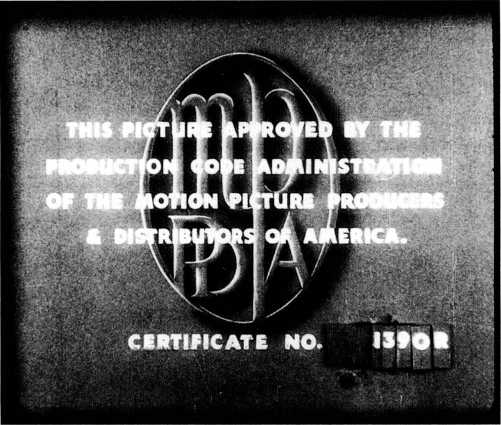The popular image of Will Hays and other officials of the Motion Picture Producers and Distributors of America (MPPDA) casts them as sour puritans imposing censorship on the film industry, The reality is more complex. The MPPDA was a corporation owned jointly by the film companies themselves. One of the MPPDA's tasks was to help avoid censorship from the outside.
The MPPDA was formed in 1922 to improve public relations after a series of Hollywood scandals, to provide a lobbying link to the era's sympathetic Republican administrations, and to handle foreign problems like quotas. Similar functions continued into the 1930s, but the MPPDA became more famous for its policy of industry self-censorship: the Production Code (often called the Hays Code).
The early 1930s were an age of conservatism. Many believed that lax morality during the 1920s Jazz Age had been one cause of the Depression. State and municipal film censorship boards, formed in the silent era, tightened standards. Pressure groups promoting religious beliefs, children's welfare, and the like protested against sex, violence, and other types of subject matter. In 1932 and 1933, a series of studies by the Payne Fund investigated the effects of filmgoing on audiences—particularly children. More voices demanded regulation of filmmaking.
By early 1930, outside pressure for censorship forced the MPPDA to adopt the Production Code as industry policy. The Code was an outline of moral standards governing the depiction of crime, sex, violence, and other controversial subjects. Provisions of the Code demanded, for example, that "methods of crime should not be explicitly presented" and that "sexual perversion or any inference to it is forbidden." (In this period, "sexual perversion" referred primarily to homosexuality.) All Hollywood films were expected to obey the Code or risk local censorship. In enforcing the
Code, MPPDA censors often went to absurd lengths. Even respectably married couples had to be shown sleeping in twin beds (to suit British censors), and the mildest profanity was forbidden. When Gone with the Wind was filmed in 1939, there was lengthy controversy before the MPPDA finally permitted Clark Gable to speak the famous line "Frankly, my dear, I don't give a damn."
The MPPDA's efforts were initially resisted by the film companies. Most of the firms were in financial trouble, some moving into or near bankruptcy as theater attendance fell; they knew sex and violence could boost theater patronage. Gangster films and sex pictures, however, drew the wrath of censors and pressure groups. Films like The Public Enemy (1931), Little Caesar (1930), and Scarface (1932) were seen as glorifying criminals. Although the protagonists were killed in the end, it was feared that youngsters would copy the tough-guy images of James Cagney and Edward G. Robinson. More notoriously, several films centered on women who traded sexual favors for material gain. Baby Face (1933) and Red-Headed Woman (1932) showed women attaining elegant apartments, clothes, and cars through a series of affairs. Even Back Street (1932, John M. Stahl), in which the heroine lives modestly and truly loves the man who keeps her, was found offensive. According to the Code's author, the film approved "of extramarital relationship, thereby reflecting adversely on the institution of marriage and belittling its obligations." 1
Mae West presented a formidable challenge to the MPPDA. She was a successful Broadway performer and playwright whose fame rested on sensational plays like Sex (1926). Although the MPPDA fought to keep her out of films, Paramount, facing bankruptcy, hired her; for a few years she was the company's top moneymaker. Her first star vehicle, She Done Him Wrong (1933, Lowell Sherman),
Universal Although it had an extensive distribution system and was the largest of the Little Three, Universal had constant money problems from 1930 to 1945 (and beyond). It had few major stars, and its successful filmmakers tended to move to bigger studios. Universal’s early strategy was to promote new stars in visually striking horror films. The firm made stars of Bela Lugosi {Dracula, 1931), Boris Karloff {Frankenstein, 1931), and Claude Rains {The Invisible Man, 1933). After 1935, Universal increasingly targeted small-town audiences, building up another new star, the cheerful teenage singer Deanna Durbin. B series were important to the studio, such as the Sherlock Holmes films of the 1940s, starring Basil Rathbone, and the slapstick Abbott and Costello series.
Columbia Under the consistent leadership of studio head Harry Cohn, Columbia weathered the Depression and remained profitable. Despite low budgets, it turned out popular films, often by borrowing stars or directors

10.1 The seal of approval as it appeared in the 1930s at the beginning of films passed by the MPPDA.

Took in many times its cost. A typical bit of dialogue occurs as the virtuous young hero chides the heroine, Lou, by asking her, "Haven't you ever met a man that could make you happy?" Lou replies, "Sure. . . lots of times." West's drawling delivery could make any line seem salacious.
The timing of the premiere of She Done Him Wrong could not have been worse. The first Payne Fund studies had just appeared. Moreover, in early 1933, the Roosevelt administration took over, severing Hays's ties to Republican officials in Washington. With growing ferment against the film industry, a national censorship law seemed to be in the offing. As a result, in March 1933, Hays pushed the film industry to enforce the Code.
Still, studios hungry for patrons tested the Code's limits. Mae West's films continued to cause problems. Belle of the Nineties (1934) was recut at the insistence of the New York State Censorship Board. The negotiations concerning this film coincided with mounting pressure from religious groups, especially the Catholic Legion of Decency. (The legion had a rating system that could condemn films either for young people or for all Catholics. This stigma could cause the industry considerable lost revenues.)
The danger of increased official censorship was too great to be ignored, and, in June 1934, the MPPDA established a new set of rules. Member studios releasing films without MPPDA seals of approval (10.1) now had to pay a $25,000 fine. More important, a film without a seal was barred from any MPPDA member's theaters—which included most first-run houses. This rule forced most producers to comply with the Code. Of course, "objectionable" material was still used, but it became more indirect. A strategic fade-out might hint that a couple was about to make love; extreme violence could occur just offscreen; sophisticated dialogue could suggest much without violating the Code.
The MPPDA may have been repressive, but it blocked potentially more extreme national censorship. In practical terms, the Code was not a tool of the prudish minds of MPPDA officials but a summary of the types of subject matter that could get movies cut by local censors or banned for Catholic viewers. The Code saved Hollywood money by pressuring filmmakers to avoid shooting scenes that would be snipped out. The MPPDA did not seek to eliminate every risque line or violent moment. Instead, it allowed the studios to go just far enough to titillate the public without crossing the lines defined by local censorship authorities.
From bigger studios (thus avoiding the costs of keeping them under contract). The studio’s most important director, Frank Capra, remained there throughout the 1930s. His 1934 film It Happened One Night starred Claudette Colbert (loaned out from Paramount) and Clark Gable (from MGM); film, director, and stars all won Oscars, and the picture was one of Columbia’s biggest hits.
Although several major directors worked briefly at Columbia—most notably John Ford for The Whole Town’s Talking (1935), George Cukor for Holiday (1938), and Howard Hawks for Only Angels Have Wings (1939) and His Girl Friday (1940)—they did not stay. The studio was largely dependent on its B Westerns and other cheaper fare (including Three Stooges films) during this era.
United Artists The sound era saw the beginning of a slow decline for UA. D. W. Griffith, Mary Pickford, and Douglas Fairbanks all retired in the early to mid-1930s, and Charles Chaplin released a feature only about once every five years. UA distributed films for other prominent independent producers such as Alexander Korda, David O. Selznick, Walter Wanger, and Samuel Goldwyn—who all switched to other firms by the end of World War II. As a result, UA was the only company whose profits fell during most of the wartime boom years.
UA’s releases from 1930 to 1945 reflect their origins from a batch of diverse independent producers. Prestigious British imports like The Private Life of Henry VIII, slapstick musicals with popular Broadway star Eddie Cantor, a few of Alfred Hitchcock’s American films (including Rebecca and Spellbound), and some of William Wyler’s finest works (Dodsworth, Wuther-ing Heights) provided a varied output. Unlike in the silent period, however, UA now had to fill out its feature schedule with mid-budget, or even B, pictures.
There was little real competition among the Majors, the Minors, and the independents. Each group had a different function within the industry. The Majors provided the bulk of the A pictures for big theaters. The Minors supplied the extra films needed and catered to smaller theaters that did not belong to the Majors. A few independent firms made prestige films, while others, like Monogram and Republic, filled in the second halves of double features with B pictures, most of them falling into the action genres, like Westerns, crime thrillers, and serials.
Some small independent producers were even further removed from the Hollywood mainstream, producing low-budget films for specific ethnic groups. Oscar Micheaux (p. 163) continued making films with black casts. The introduction of sound led to production in a variety of languages. In cities where there were large enclaves of Jewish immigrants, for example, there was a demand for films in Yiddish. While there had been silent films distributed with Yiddish intertitles, the talkies fostered a brief flowering of Jewish-oriented production in the 1930s. Films such as Uncle Moses (produced by Yiddish Talking Pictures in 1932) were shown in theaters that also exhibited movies imported from the two other centers of Yiddish filmmaking, the USSR and Poland. Edgar G. Ulmer, who had worked briefly in Hollywood, made one of the most internationally successful Yiddish films, Green Fields (1937). Other directors adapted works from the popular theater. Many Yiddish films centered on family crises and the clash between traditional values and modern urban life. The films featured frequent musical interludes. The outbreak of World War II crushed Yiddish filmmaking in Poland in 1939, and, by 1942, Yiddish-language production had ceased in the United States as well.
Despite the limited successes of various types of independent production, it would have been virtually impossible for a new company—large or small—to gain a significant share of the film market. The existing Hollywood firms had created a secure, stable situation in which they loaned each other stars, played each other’s films in their theaters, and cooperated in other ways. In one of their most prominent joint actions, they worked through the Motion Picture Producers and Distributors of America to fight outside pressure for censorship of movies (see box p. 216).




 World History
World History









